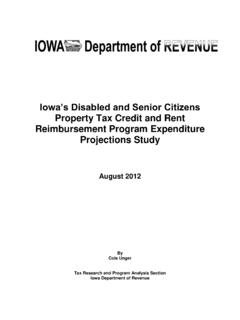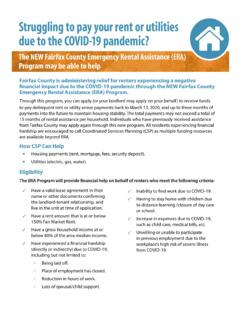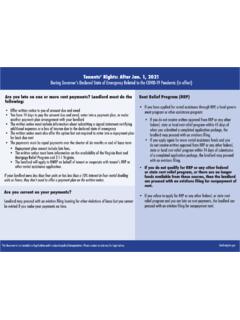Transcription of Exact inductance equations for rectangular conductors with ...
1 JOURNAL OF RESEARCH of the National Bureau of Standards-C. Engineering and Instrumentation Vol. 69C, , April-June 1965 Exact inductance equations for rectangular Con-ductors With Applications to More Compli-cated Geometries Cletus Hoer* and Carl Love* (January 11, 1965) Exact equations a re given for t he calculation of t h e self- inductance of rcctangular con-ductors and of t he lIlutual inductance between combinations of para llel fil a mc n ts, thin tapcs and rectangular conductors . A general procedure is also g iven for calculating th e sclf- inductance of complicated geometries by dividing the gcometry into s imple elcm e nts whose inductances can be calc ulated. This general proccdure is valid for conductors having nonuniform, as well as uniform current dcnsities. 1. Introduction It is the pmpose of this paper to give a number of Exact equations fot' the self-and mutual inductance of rectangular conductors , and also to show how these equations may be combined to obtain Exact inductance olutions for more complicated geometries.
2 These equations were derived dUl'ing a recent investigation of thin tapes as possible high frequtlncy inductance standards. A number of approximate equations exist for calculating the inductance of rectangular ~onductors [1-5].1 The usual method is to calculate the mutual inductance between two fila-ments spaced a distance apart equal to the geometric-mean-distance [6] of the conductor or conductors . This method assumes that the length is much greater than the other dimensions. However, when the length is no larger than ten times the next largest dimension, the error from this method may be as large as several percent. It is for those cases where a high degree of aCCUl'acy is needed that the equations in this paper have been derived. 2 . Mutual inductance Calculations In general, the mutual inductance between two conductors will b e a function of the current distribution in each conductor.
3 A conductor having a constant cross-sectional area 2 along its length may be thought of as a bundle of parallel filaments, each having a cr oss-sectional area dA and carrying a CUl'rent JdA. The current density, J , is assumed to be constant along the length of each filament but to vary from filament to filament. The mutual inductance , M , between two conductor s having constant cross-sectional areas Al and A2 and carrymg c urren ts 11 and 12 may be derived from energy considerations and is (1) where M12 is the mutual inductance between a filament carrying a CUl'rent J 1dAl in the first con-ductor and a filament carrying a CUl'rent J2dA2 in the second conductor. Since it is assumed that the CUl'rent is constant along the length of each filament, the mutual inductrLllce between ' R adio Standards Ellginecring Division, NBS Boulder Laboratories, Boulder, Colo.
4 I Figures in brackets indicate the lite rature ref erences at the end of this paper. I .e., tne cross section dimensions do not change. 65-3 127 / any two of the filaments is given by Neumann's formula, (2) The distance r is between two elements of length dl1 and dl2 which are along two filaments having total length l1 and l2' respectively. For dimensions in centimeters, M12 is in micro-henrys. Since inductance cannot be cal culated or sp ecified except for a closed circuit, the integrals of (2) are u sually over a closed path. However, the se1 -and mutual inductance of parts of a closed circuit (su ch as those to follow) may be calculated, provided that the total inductance of t h e circuit includes the contribution from each part. If the current density is constant thr ou ghou t each conductor, (1) reduces to (3) which is independent of the current in either conductor and a function of only their dimensions.
5 Using (2) and (3), the mutual inductance between any two conductors having constant cross-sectional areas and u niform (but not necessarily equ al) current densities may be evaluated. Results obtained from (2) and (3) are quite u seful even though the current densities are not uniform. In many cases, the condu ctors m ay be subdivided into elements small enou gh so that each element may b e considered as having a uniform cmrent densi ty. The mutu al inductances between t h e smaller elements are then properly summed to get the total m utual inductance . R esults from (2) and (3) are also useful when the cross-section al area of a con-ductm is not uniform alon g its length . In this case th e conductor is subdivided into sections, each of which has a constant cross-sectional area al ong its length. The mutual inductance between sections are t h en properly summed to get the total mutual inductance .
6 The techniqu e of subdividing conductors into sm aller elements whose inductance can be calculated is d eveloped at the end of this paper. Mutual inductance Between Parallel Filaments The first step in calculatin g th e mutual inductance between parallel tapes or b ars is to cal culate the mutual inductance between parallel filaments using Neumann 's formula. The mutual inductance , MfJ between two parallel filaments of length l J and l2 sp aced in any relative position is where y (4) FIGURE 1. Two parallel filaments whose mutual inductance is given by eq (4). 128 The dimen ions are defined in figure 1. If the left end of l2 is to the left of the y-axis, the value of l3 will be negatiye. The value of Mf is in microhenrys for dimensions in centimeters. This one equation covers all possible positions of two parallel fliaments. It is given in its expanded > form for special cases elsewhere in the literature [1, 7].
7 F ~ I I Mutual inductance Between a Thin Tape and a Filament The mutual inductance , Mtl> between a fliamen t and a thin tape parall el to the fliament such as shown in figure 2 is obtained by putting lJ;[f into (3) and integrating over the width of the thin tape. (5) where p2=P 2+ (E_X)2 in M,. Since z in .LVI, is not a function of x (that is, the limits of integration 81, 82, 83, and 84 are independent of x) , it is unnecessary to expand NI11 and the two terms inside of the brackets of (4) can be integrated as they are. This integration gives (6) where The positive directions for E, P, and l3 are tak en as the positive directions of the x, y, and z axes, respectively. If t h e back end of the filament is in an y octant other than that shown in figure 2, some or all of the values of E , P, and l3 will be negative. In this equation and in those following, the principal value of the inverse tangent is to be used.]
8 2 .3. Mutual inductance Between Two Thin Tapes To obtain the mutual inductance , Mt, between two p ar allel thin tapes of zero thickness , such as shown in figure 3, M, is integrated over all fliaments in both tapes. +y +y 1----E --.,.. +Z +z FIGURE 2. A filament pamllel to a thin tape whose FIGURE 3. Two parallel thin tapes whose m u tual m u tual inductance is given by eq (6) . inductance is given by eq (8) . 129 l 1_ (7) (8) where The distance E is measured from the y z plane to the left edge of the second tape. If the back left corner of the second tape is in any octant other than that shown in figure 3, some or all of the values of E, P, and l3 will be negative. The mutual inductance , , between two thin tapes whose axes are parallel but whose widths are perpendicular to one another such as shown in figUI'e 4 is (9) where P in Mlr has been replaced by the variable y.
9 This integration gives (10) where The distance P is measured from the xz plane to the bottom of the second tape. +y 130 FIGURE 4. Two thin tapes whose axis are parallel but whose widths are perpendiculw', 'l'he mutual is given by eq (10). 1 Mutual Inductanc e Between a Bar and a Filament The mutual inductance , Mbh between a rectangular bar and a filament parallel to the bar such as shown in figure 5 is obtained by integrating M,! over all thin tapes in the bar. Equation (3) gives 1 Ibia 1 f P M;1xdY=-b M,;1Y, a 0 0 P-b (11) where Pin .M'I is now replaced by the variable Y =.P -y. The integrfLtion of (11) is identical to the integration of (9) except for the limits of inLegration and the constant. (12) where j(x, y, z) is the expression within the inner brackets of (10). The di stance P in (12) is measured from the xz plane to the filament.
10 Mutual inductance Between rectangular Bars To obtain the mutual inductance , , between two l'ecLangular bars, is integrated over all thin tapes in both bars. M b= ble J;+ , (13) where P in is replaced by the variable (Y2-YJ)' Since the x and z limits of integration on are independent of y, the four terms inside the brackets of (8) may be integrated as they are. After a l engthy integration, (13) yields an Exact expression for the mutual inductance between two parallel rectangular bars spaced in any relative position. F I G URE 5. A filament pm'allel to a rectangular bar whose m utual indu ctance is given by eq (12). 131 +y r----E --) , p ./ +x +y where O---;r---/-;H+--'--1+-+x FIGURE 6. Two parallel rectangular bars whose mutual inductance is given by eq (14). The dimensions are defined in figure 6. Either bar may be placed so that its back lower left corner is at the origin.












